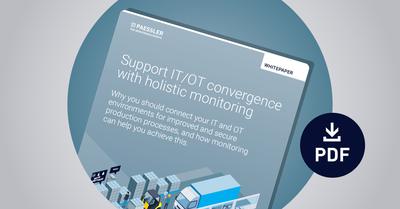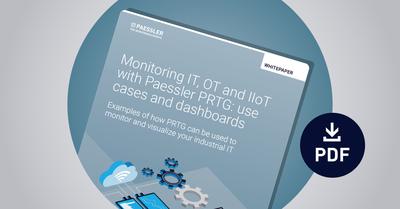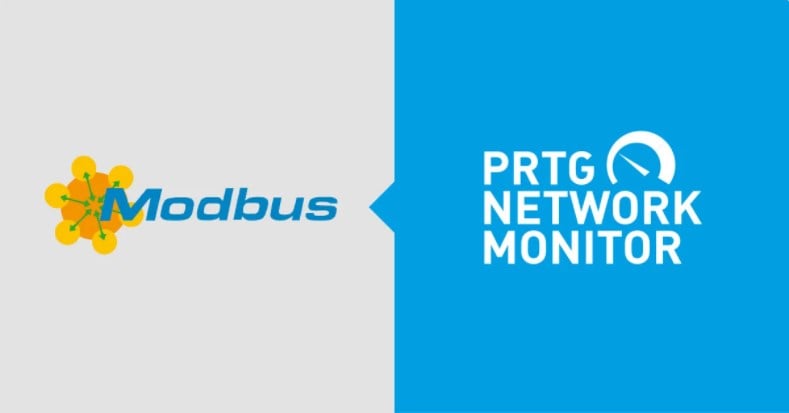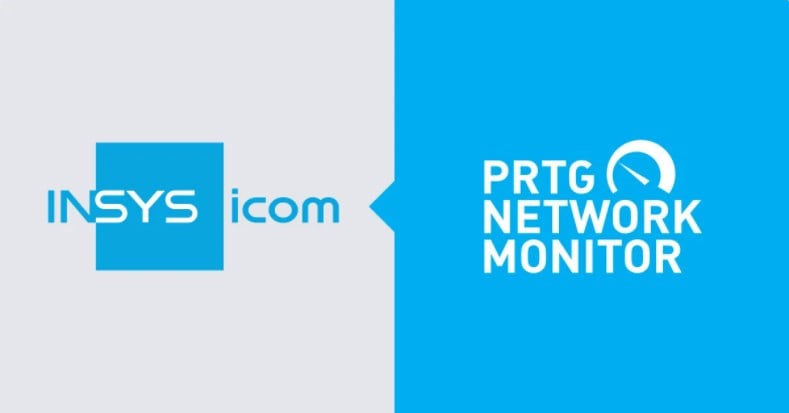Monitor your industrial
environment using OPC UA
OPC UA monitoring keeps track of your general server and PLC state
Identifies errors at an early stage during the manufacturing process
Alarm management system
for your plant
PRTG: the all-in-one monitoring solution for IT/OT environments
OPC UA stands for OPC Unified Architecture. It is an extensible, platform-independent standard that enables the secure exchange of information in industrial systems.
Read more
In the context of a converged IT (information technology) and OT (operational technology) setup, OPC UA data can also be used to enhance the overall capabilities of an all-in-one monitoring system like PRTG.
OPC UA is a platform-independent communication framework that runs on any software platform like Windows, Linux, macOS, or Android. From simple, embedded controllers to massive cloud infrastructure. It is equally suited for use on premises, inside a closed network or to establish connectivity to a cloud platform via the internet. Security is baked into the protocol for access control, authentication, and encryption. Because of its flexibility, OPC UA has been widely adopted in industries like automotive, food and beverage, oil and gas, energy and utilities, packaging, and building automation. PRTG offers these built-in OPC UA sensors:
OPC UA Certificate sensor
OPC UA Custom sensor
OPC UA Server Status sensor
Beckhoff IPC System Health sensor
Get an overview of OT network components in your supervisory and control systems
You want the FULL overview of your OT environment in your supervisory and control systems – including the network components like routers, switches, firewalls, and more. Paessler PRTG OPC UA Server brings monitoring data from your OT network and the IIoT into your control overview to give you centralized monitoring and alarms. See everything in one place.
The advantages of device monitoring using OPC UA with PRTG
The ability of PRTG Network Monitor to monitor devices using OPC UA, Modbus, MQTT and more means that it is
an all-in-one monitoring solution that can combine the IT and OT worlds in one single overview.
Easy OT monitoring
Monitoring does not have to be complicated. With the OPC UA sensors included in PRTG, you can monitor your OT devices without much configuration effort by providing a user-centric GUI to simply add devices, define notifications and create fully customized dashboards. This way, you easily get an overview of your whole plant!
One overview
In industrial IT environments, many OT devices cannot be monitored with traditional IT monitoring methods or protocols. However, these two worlds are becoming more and more convergent. PRTG combines these two worlds giving you over 20 years of IT monitoring experience and widely used industry protocols like OPC UA, Modbus, and MQTT.
Predictive maintenance
When monitoring OT components, one of the most important goals is predictive maintenance. Prevent malfunctions and failures to avoid that production lines stop and high costs are incurred. OPC UA monitoring with PRTG reliably informs you about the state of the various components of your production line.
IT/OT convergence with PRTG Network Monitor
PRTG Network Monitor is an excellent IT monitoring solution that combines a wide scope of features with great usability and maximum flexibility. In addition to out-of-the-box support for all common IT standards, PRTG provides a RESTful API as well as OPC UA, MQTT, and Modbus support for easy plant integration. In addition, PRTG supports monitoring for IoT devices, environmental metrics, and other IT equipment and applications that do not use common standards.
OPC UA – how does it work?
OPC UA enables access to machines, devices, and other systems
- OPC UA server: The OPC UA server is the basis of OPC communication. It is a software program that implements the OPC standard and thus provides the standardized OPC UA interfaces to the outside world. The proprietary communication protocol for the manufacturer's control is implemented inside. OPC UA servers are provided by various parties.
- OPC UA client: The OPC UA client is the logical counterpart to the OPC UA server. The OPC UA client can be connected to the OPC UA server and read out the data provided by the server. Since the OPC UA servers implement the specified interfaces of the OPC UA standard, each client can access any OPC UA server and exchange data with the server in the same way.
What is OPC UA?
OPC UA (short for Open Platform Communications Unified Architecture) is a data exchange standard for industrial communication (machine-to-machine or PC-to-machine communication). The open interface standard is independent of the manufacturer or system supplier of the application, the programming language in which the respective software was programmed and the operating system on which the application works.
We are an OPC Foundation Member and therefore at the forefront of implementing the latest standards in industrial IT
Paessler is a registered OPC Foundation member, an industrial consortium that creates and maintains standards for open connectivity of industrial automation devices and systems. By being part of the community, Paessler is at the forefront of implementing the latest standards in industrial IT and provides its customers with the latest data insights into OT and IT.
Get your free white papers
White paper I
In modern industrial IT, the right teams need the right data. Our guide shows how to implement holistic monitoring that brings elements from IT, OT and IIoT into your dashboards.
White paper II
Our second guide gives you inspiration and ideas for dashboards that feature IT, OT and IIoT data – all in one place. We show you what truly convergent industrial dashboards look like!
The OPC UA sensors and what they monitor
How PRTG defines sensors
In PRTG, “sensors” are the basic monitoring elements. One sensor usually monitors one measured value in your network, e.g. the traffic of a switch port, the CPU load of a server, the free space of a disk drive. On average you need about 5-10 sensors per device or one sensor per switch port.
OPC UA Server Status sensor
The OPC UA Server Status sensor monitors status, uptime, and diagnostic information of your OPC UA server. With this new sensor type, you can ensure your devices are available via OPC UA and that your production processes run flawlessly.
OPC UA Custom sensor
The OPC UA Custom sensor monitors up to five numeric values returned by specific OPC UA node IDs. With this sensor type, you can retrieve information such as the PLC state, when a battery needs to be replaced, device failure, and system-specific error states.
OPC UA Certificate sensor
The OPC UA Certificate sensor monitors the certificate of an OPC UA server and helps you to ensure a secure and consistent communication between the machines in your shop floor.
OPC UA Notifications
OPC UA Notifications enables you to forward PRTG alerts by writing them to a predefined OPC UA tag on an OPC UA server like SCADA, DCS, or any other system that provides OPC UA server capability.
Beckhoff IPC System Health sensor
The Beckhoff IPC System Health sensor monitors the system health of a Beckhoff Industrial PC (IPC) via OPC UA.
Create innovative solutions with Paessler’s partners
Partnering with innovative vendors, Paessler unleashes synergies to create
new and additional benefits for joined customers.
With ScriptRunner, Paessler integrates a powerful event automation platform into PRTG Network Monitor.
ScriptRunner
Keep industrial monitoring
professional with PRTG
IIoT, Industry 4.0, M2M – the digitalization of production is currently taking place and has become a decisive factor in remaining competitive in a global market. Historically separated production facilities and machines require access to the internet for logistics, predictive maintenance, and customer-specific production. These requirements call for integrated communication, which is only possible with traditional IT. IT/OT convergence, the fusion of production and classic IT, is the result. It is essential for preventing risks, eliminating obstacles, and implementing new processes.
Get more industry-specific
information here!
OPC UA monitoring is great but would you like to discover more about industrial IT monitoring?
Then be sure to check out our blog posts and web pages.
Monitoring Modbus TCP data
For IT professionals in a factory setting who are maintaining traditional network elements and industry-specific infrastructure, Modbus TCP devices often contain important information needed for monitoring the entire infrastructure.
Introducing the new MQTT sensors for PRTG
Read about the MQTT sensors in PRTG that help you get a comprehensive overview of the IoT devices in your infrastructure.
INSYS icom and PRTG: a use case in getting data from the factory floor
How exactly can smart gateways be used to get OT data into an IT monitoring concept? Let’s examine one possible solution by looking at an example with INSYS icom gateways and the new MQTT Subscribe Custom sensor of PRTG Network Monitor.







